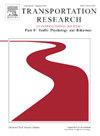建立自行车基础设施和交通条件的影响、安全性和舒适性的规范分数
IF 3.5
2区 工程技术
Q1 PSYCHOLOGY, APPLIED
Transportation Research Part F-Traffic Psychology and Behaviour
Pub Date : 2025-06-10
DOI:10.1016/j.trf.2025.06.006
引用次数: 0
摘要
对安全性和舒适性的感知是骑自行车者用户体验的关键组成部分,并影响骑自行车的吸收。现有的基于视频的调查显示,自行车和机动车分离程度越高的环境,其主观安全性和舒适性越高。然而,这些研究没有比较公路和越野自行车基础设施,主观安全/舒适与情绪测量之间的关系,也没有建立具有代表性样本的安全与舒适的规范性分数。本调查研究的目的是在年龄和性别具有代表性的18至80岁的澳大利亚成年人样本(N = 1737)中,为描述第一人称在不同基础设施和交通环境中骑行的视频片段建立规范性的情感得分(定义为感知的安全性、舒适性、效价和唤醒)。结果表明,越野共享车道和独立自行车道提供了主观上最安全、最舒适的骑行环境,而在低交通水平下,涂漆自行车道和混合交通环境的影响得分存在显著重叠。线性多层模型揭示了性别、骑车信心和盖勒类型在影响得分上的差异。效价、觉醒、安全和舒适的得分高度相关。这些结果突出了跨人口统计子群体的主观感知的个性,以及在研究中需要代表性样本。他们还强调,规划者需要优先考虑越野共享路径和独立的自行车道,这些都能提供最积极的骑行体验。最后,在设计基础设施时考虑到用户体验(即培养积极的情绪和安全),可能会让骑自行车更有吸引力,鼓励更多的人骑自行车。本文章由计算机程序翻译,如有差异,请以英文原文为准。
Establishing normative scores of affect, safety, and comfort for bicycling infrastructure and traffic conditions
Perceptions of safety and comfort are key components of bicyclist user experiences and influence bicycling uptake. Existing video-based surveys show that environments with greater separation of bicycle and motor traffic are associated with greater subjective safety and comfort. However, these studies have not compared on-road and off-road bicycling infrastructure, the relationship between subjective safety/comfort and measures of emotion, nor established normative scores of safety and comfort with representative samples. This survey study aimed to establish normative scores of affect (defined as perceived safety, comfort, valence and arousal) for video clips depicting first-person riding in different infrastructure and traffic environments in an age and gender representative sample of Australian adults aged 18 to 80 years (N = 1737). Results showed that off-road shared paths and separated bike lanes provided the subjectively safest and most comfortable riding environments, while there was significant overlap in affect scores for painted bike lane and mixed traffic environments in low traffic levels. Linear multilevel models revealed gender, bicycling confidence, and Geller typology differences in affect scores. Scores of valence, arousal, safety, and comfort were highly correlated. These results highlight the individuality of subjective perceptions across demographic sub-groups and the need for representative samples in research. They also reinforce the need for planners to prioritise off-road shared paths and separated bike lanes, which offer the most positive biking experiences. Finally, designing infrastructure with user experiences in mind (i.e., to foster positive emotions and safety) may make biking more attractive, encouraging more people to ride.
求助全文
通过发布文献求助,成功后即可免费获取论文全文。
去求助
来源期刊
CiteScore
7.60
自引率
14.60%
发文量
239
审稿时长
71 days
期刊介绍:
Transportation Research Part F: Traffic Psychology and Behaviour focuses on the behavioural and psychological aspects of traffic and transport. The aim of the journal is to enhance theory development, improve the quality of empirical studies and to stimulate the application of research findings in practice. TRF provides a focus and a means of communication for the considerable amount of research activities that are now being carried out in this field. The journal provides a forum for transportation researchers, psychologists, ergonomists, engineers and policy-makers with an interest in traffic and transport psychology.

 求助内容:
求助内容: 应助结果提醒方式:
应助结果提醒方式:


